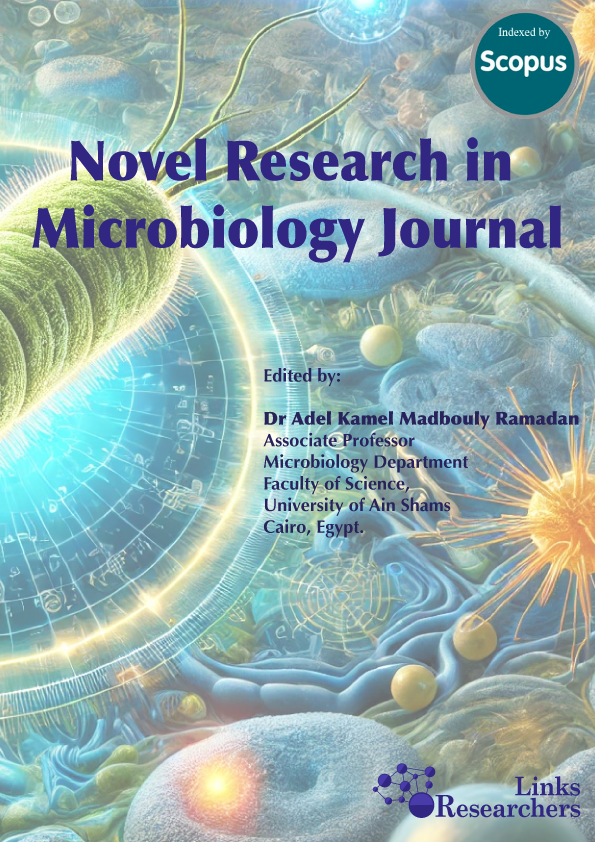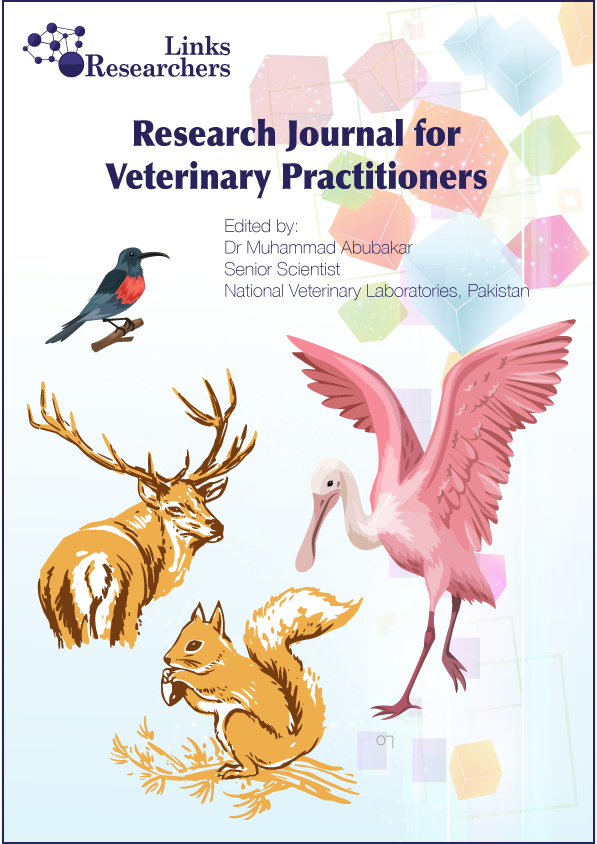Muhammad Ashraf Khan1, Hizbullah Khan1, Abid Farid2
Muhammad Mushtaq
E-mail | mushtaq@uaar.edu.pk
Klara Fischer1*, Erika Chenais1,2, Emeli Torsson1, Jonas Johansson Wensman1
Sana Rana1, Sajid Abdullah1, Huma Naz2* and Khalid Abbas1
Tanzeela Riaz*†, Farah Rauf Shakoori, Syed Shahid Ali
Shagufta Andleeb*
Zubair Ahmed#, Muhammad Farhanullah Khan, Habiballah Rana*
induced lethal effects in S. zeamais. Probit analysis revealed LD50 value for H.
recurvum plant extract were 16.47 μg/insect and chlorantraniliprole were 0.0358
μg/insect, after 24 hours. The result revealed that H. recurvum plant extract had
insecticidal potential against the stored grain pest, S. zeamais. Current study
suggests H. recurvum plant extract could be a good alternative against
conventional...
Madeeha Arshad, Asmatullah, Chaman Ara
agent. Present research work is focused on the teratogenic impacts of sodium
arsenate given to gravid mice (Mus musculus). Different doses of sodium arsenate
18.25, 37.5 and 75mg/kg B.W. were administered orally at day 6 of gestation
(single exposure group) to 15 females/dose group along with one control group
having 15 females, which was given only distille...
Abdul Khaliq1, Muhammad Irfan Ullah1,*, Muhammad Afzal1, Akhlaq Ahmad2 and Yasir Iftikhar3
Huma Naz1,*, Sajid Abdullah2, Khalid Abbas2 and Muhammad Anjum Zia3
Attaur Rahman1, Sadeeq ur Rahman1,*, Ashfaq Ahmad2, Abdul Sajid1, Muhammad Asif Hussain1, Mian Muhammad Salman1, Niamat Ullah Khan1, Kamran Khan3, Fazli Rabbani1, Muhammad Akbar Shahid4, Irshad Ahmad5 and Shakoor Ahmad6
Muhammad Shahzad Akbar*, Maria Aslam, Muhammad Rehan Khalid, Shahid Iqbal, Muhammad Luqman and Muhammad Zeeshan Majeed
Hafiz Abdullah Shakir1*, Javed Iqbal Qazi2, Abdul Shakoor Chaudhry2, Muhammad Irfan3, Muhammad Khan1, Shaukat Ali4 and Saima Shahzad Mirza5
Saleha Ashfaq1, Manzoor Hussain1, Nazish Bibi2, Jan Alam1, Muhammad Junaid2 and Sabi-Ur-Rehman3*
Hamza Rehman*, Nida Ahmad Khan, Asad Ali, Warda Batool and Kanwal Razzaq
Muhammad Shahid1*, Unsar Naeem-Ullah1, Waheed S. Khan2, Shafqat Saeed1 and Kashif Razzaq3
Rahat Afza, Muhammad Asam Riaz*, Muhammad Afzal and Muhammad Zeeshan Majeed
Muhammad Arslan Ibrahim1*, Aneeqa Aleem2, Farkhanda Manzoor2, Shahbaz Ahmad1, Hafiz Muhammad Zahid Anwar1, Talia Aroob2 and Mansoor Ahmad3
Saima Naz1*, Ahmad Manan Mustafa Chatha2, Saba Saeed1
Ramy S. Yehia1,3, Essam A. Shaalan2* and Hashem M. Al-Sheikh1
Qaisra Siddique1*, Sajid Abdullah1, Huma Naz2, Khalid Abbas1, Laiba Shafique1 and Qingyou Liu3
Samia Azad1, Iram Liaqat1*, Riffat Iqbal1 and Uzma Rafi2
Saima Mehar1 and Salma Javed2*
Deepesh Kumar Bhuptani1, Atta Hussain Shah1*, Gul Bahar Khaskheli1, Zubair Ahmed Laghari2, Ghulam Shabir Bahram1, Muneer Ahmed Jamali1, Tarique Ahmed Khokhar1
Hamenya Mpemba1, Fan Yang1, Kirsty J. MacLeod2,3, Dusu Wen1, Yan Liu1,4 and Guangshun Jiang1,*
Nosheen Jehajo*, Nasreen Memon, Mansoor Ali Shah and Naheed Shah
Emtiaz Ibrahim Ghoniem, Gaber Mamdouh Abdelgalil, Amira Farouk Gad* and El-Sayed Hassan Eshra
Arif Mehmood1*, Muhammad Naeem2, Abu Bakar Muhammad Raza1, Muhammad Asam Riaz1, Muhammad Zeeshan Majeed1, Nadra Khan3 and Waqas Raza4
Sayed H. Al Habty1, Dina N.Ali2*
H. M. Hassan† and S. A. Ibrahim
MARIUM ASLAM, MUHAMMAD JAVED, FAIZA AMBREEN* & FARIHA LATIF
Dalia Mansour Hamed1, Mohsen Zaky El Dimerdash1, Ahmed Abdelatif Ali2, Samer Adel Abd El-Gaffar3, Mona Salim Abdallah1*
Keywords | Antibiotic; Mortalities; Nursing; Probiotic; Rabbit; S. aureus.
...Safaa Rhaimi1, Sara Brikat2, Mouloud Lamtai2*, Mohammed Ouhssine1
Rafik Soliman1*, Rafik H. Sayed2, Hanan Mahmoud3, Heidy Abo El-Yazeed1, Marsell Saad1, Shaimaa Abdelall Elsaady2, Khalid Sh3
Selvaraj Thanga Malathi¹, Venkatraman Anuradha1*, Mohamed Yacoob Syed Ali2, Muhameed Sajjad Sarwar3, Nagarajan Yogananth2
Bing Yan1, Meng Meng Zhang2, Xi Chen2, Yongming Li2*, Muhammad Khan3* and Tonghui Ma1*
Faiza Naeem1, Muhammad Farooq Sabar1, Muhammad Usman Ghani2,*, Qurat Ul Ain1 and Qurat-ul-Ain Zafar1
Wei Wan1, Xiao-Li Wang1, Shu-Juan Wang2, Qin Si2 and Li-Qing Duan1*
Rana Mahmood Ahmad*, Orooba Mohammed Maeed Ibrahim
Xiaojun Li
Hongsen Xu*, Xiaoni Wang, Tie Tian, Changyu Zhao, Denghang Yu and Jun Liu
Ghaith Z. Hasan Al-Askari *, Eman H. Yousif Al-Taee
Moazama Batool1*, Saima Naz2*, Sheeza Bano1, Sadia Nazir3, Ghulam Abbas4, Ahmad Manan Mustafa Chatha5, Maria Lateef2 and Fatima Yasmin2
SHEIKH AJAZ RASOOL1, MUHAMMAD SALMAN RASOOL2 & MUNAZZA AJAZ3
Muhammad Wasif Gulzar*, Riffat Maqsood, Muhammad Zain, Muhammad Suleman, Tayyab Ur Rehman, Sana Asif, Abdul Wadood and Jawad Hussain
Moazama Batool1*, Syeda Ansa Fatima1, Saima Naz2*, Qurat Ul Ain1, Sheeza Bano1, Ghulam Abbas3 and Ahmad Manan Mustafa Chatha4
Chika Bright Ikele1*, Ugwu Venita Uju1, Chioma Faith Ikele2
Sumaira Fiaz1*, Huma Naz1*, Tanveer Ahmed2*, Iqra Zulfiqar1, Khalid Mehmood1, Muhammad Jabbar1, Syed Qaswar Ali Shah1, Muhammad Usman4
Hala Harifi*, Mouloud Lamtai*, Siham Ait Salhi, Fatima-Zahra Azzaoui, Omar Akhouayri, Abdelhalem Mesfioui, Leila Bikjdaouene
Ying Zhong1,3,4, Jingni Chen1, Chunping Huang1, Huaiyuan Jin1, Jinlu Huang1, Lining Zhao1, Yi Geng3, Guiping Wang1,4 and Xueqiao Qian1,2*
Wazir Ahmed1*, Muhammad Naeem Akhtar2, Muhammad Waseem Akhtar3, Muhammad Nauman Hanif1, Aiman Salah ud Din4 and Ahmad Mahmood1
Abd El-Alim F. Abd El-Alim1, Abdelhakeem El-Murr2*, Tahsein Hasan1
Yasser Asaad Hameed Al-Shareef, Firas Hussain Kadim Abawi*
Song Jiang1,2,3, Zhenhua Ma1,2, Falin Zhou1,2, Xu Chen1, Jing Hu1, Rui Yang1, Shengjie Zhou1, Yundong Li2 and Qibin Yang1*
Waithaka, P.N.1*; Mwaura, F.B.1; Wagacha, J.M.1; Gathuru, E.M.2; Githaiga, B.M.2
Sagorika Rai; Pallabi Banerjee; Anshuman Chandra; Imteyaz Qamar*
Huma Naz1*, Sajid Abdullah2, Fariha Latif3, Farzana Abbaasi4, Naila Hadayat5, Tanveer Ahmed6*, Khalid Abbas2 and Muhammad Adeel Hassan7
Moushumi Purkayastha1*, Rakibul Hasan1, Kazi Asma Akther2, Chhanda Rani Das3, Shofiqul Islam1, Shahriar Rahman Sagar4, Saiful Islam5, Sohag Talukder5, Bashudeb Paul5, Sultan Ahmed1, A.T.M. Mahbub-E-Elahi1
















